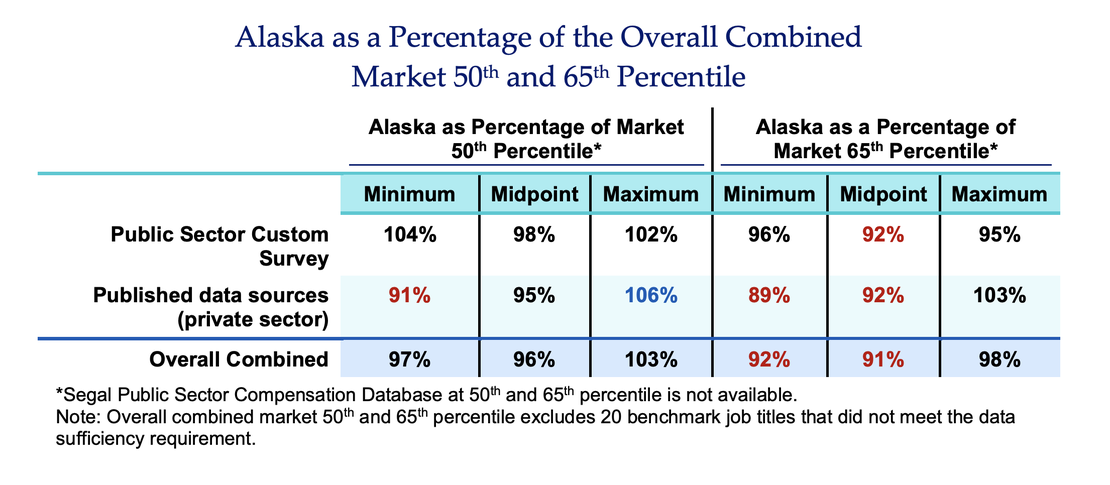
Alaska State Salary Study: What the Numbers Really Tell Us
TL;DR
- At Market? Not Quite. Many Alaska state job series fall short of national market benchmarks.
- 65th Percentile is the Standard. Legislative intent is clear: target the 65th percentile—not the 50th.
- The Math Matters. Being paid 92% of market isn’t an 8% shortfall—it’s nearly a 9–10% raise away from parity.
- Raising Wages is Non-Negotiable. Even if the administration targets lower benchmarks, the gap remains, and so do the needed raises.
In a recent study published by the state (study link), Alaska’s pay rates were compared against both the 50th and 65th market percentiles. The tables reveal that while some positions measure above market levels, many fall short—sometimes by a margin that, when properly understood, is more significant than it first appears.
The Essentials at a Glance
The report breaks down salary ranges using progression steps:
- A Step: Entry-level salary (Minimum)
- F Step: Approximately 5 years in (Midpoint)
- O Step: 15+ years in (Maximum)
The aggregated “Overall Combined” data shows how Alaska fares, as a percentage of national market pay, for these steps:
| Percentile | Point | Alaska % of Market |
|---|---|---|
| 50th | Minimum | 97% |
| 50th | Midpoint | 96% |
| 50th | Maximum | 103% |
| 65th | Minimum | 92% |
| 65th | Midpoint | 91% |
| 65th | Maximum | 98% |
Key Point: The standard—and legislative intent—is to target the 65th percentile. So even if wages are set to align more closely with the 50th percentile, they are still falling short of the intended target, and raises are needed to meet the proper benchmark.
When 92% Isn’t as Close as It Looks
It’s easy to see a figure like 92% and think, “That’s pretty close to market rate.” But when we move from percentages to actual dollars—especially in the salary ranges that most public employees live within—the story changes.
Let’s take a $50,000 market salary as an example:
- 92% of $50,000 is $46,000
- That’s a $4,000 shortfall from the market rate
- But here’s the real kicker: To go from $46,000 to $50,000, you don’t just need an 8% raise
You need a raise of:
(50,000 - 46,000) / 46,000 = 8.7%
So, a person earning $46,000 would need an 8.7% raise to reach $50,000—not just 8%. That extra 0.7% might sound small, but across a department, an agency, or the entire public workforce, it represents a significant investment. And more importantly, it represents the real cost of pay parity.
This kind of precise math matters because it moves the conversation beyond “close enough” and into what’s fair—based on the standards we’ve already agreed to follow.
Consider these calculations for clarity:
| Percentile | Point | Alaska % of Market | Raise Needed (%) |
|---|---|---|---|
| 50th | Minimum | 97% | ~3.09% |
| 50th | Midpoint | 96% | ~4.17% |
| 50th | Maximum | 103% | 0.00% |
| 65th | Minimum | 92% | ~8.70% |
| 65th | Midpoint | 91% | ~9.89% |
| 65th | Maximum | 98% | ~2.04% |
Why This Matters
Understanding these nuances is vital. When aggregated data shows that some roles average, say, 91–92% of the market on the 65th percentile, it might seem like a modest gap at first glance. But when you apply the proper multiplicative correction, it becomes clear that these positions are nearly 10% short of what the market deems competitive. This isn’t just an academic point—it’s about ensuring that public service employees receive compensation that reflects their expertise and dedication.
A Call for Clearer Conversations
This analysis isn’t about casting blame—it’s about transparency and fairness. The data we see is an aggregate that masks critical discrepancies between job series. With the legislative intent clearly set on reaching the 65th percentile, falling short of that goal means that even when lower benchmarks are targeted, the reality is that substantial raises are still required. It’s a reminder that in our discussions on public service pay, every percentage point matters.
Let’s use these insights to foster a dialogue grounded in clear figures and shared values, ensuring that our public servants receive the salary parity they deserve.